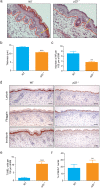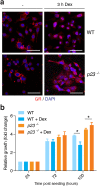Defective glucocorticoid receptor signaling and keratinocyte-autonomous defects contribute to skin phenotype of mouse embryos lacking the Hsp90 co-chaperone p23
- PMID: 28650975
- PMCID: PMC5484504
- DOI: 10.1371/journal.pone.0180035
Defective glucocorticoid receptor signaling and keratinocyte-autonomous defects contribute to skin phenotype of mouse embryos lacking the Hsp90 co-chaperone p23
Abstract
p23 is a small acidic protein with intrinsic molecular chaperone activity. It is best known as a co-chaperone of the major cytosolic molecular chaperone Hsp90. p23 binds the N-terminus of Hsp90 and stabilizes the ATP-bound and N-terminally closed Hsp90 dimer. It is in this configuration that many Hsp90 clients are most stably bound. Considering the important role of p23 in the Hsp90 cycle, it came as a surprise that it is not absolutely essential for viability in the budding yeast or for mouse development. Mice without p23 develop quite normally until birth and then all die perinatally because of immature lungs. The only other apparent phenotype of late stage embryos and newborns is a skin defect, which we have further characterized here. We found that skin differentiation is impaired, and that both apoptosis and cell proliferation are augmented in the absence of p23; the consequences are a severe thinning of the stratum corneum and reduced numbers of hair follicles. The altered differentiation, spontaneous apoptosis and proliferation are all mimicked by isolated primary keratinocytes indicating that they do require p23 functions in a cell-autonomous fashion. Since the phenotype of p23-null embryos is strikingly similar to that of embryos lacking the glucocorticoid receptor, a paradigmatic Hsp90-p23 client protein, we investigated glucocorticoid signaling. We discovered that it is impaired in vivo and for some aspects in isolated keratinocytes. Our results suggest that part of the phenotype of p23-null embryos can be explained by an impact on this particular Hsp90 client, but do not exclude that p23 by itself or in association with Hsp90 affects skin development and homeostasis through yet other pathways.
Conflict of interest statement
Figures






Similar articles
-
Structural elements in the flexible tail of the co-chaperone p23 coordinate client binding and progression of the Hsp90 chaperone cycle.Nat Commun. 2021 Feb 5;12(1):828. doi: 10.1038/s41467-021-21063-0. Nat Commun. 2021. PMID: 33547294 Free PMC article.
-
The Hsp90 cochaperone p23 is essential for perinatal survival.Mol Cell Biol. 2006 Dec;26(23):8976-83. doi: 10.1128/MCB.00734-06. Epub 2006 Sep 25. Mol Cell Biol. 2006. PMID: 17000766 Free PMC article.
-
Structure of Hsp90-p23-GR reveals the Hsp90 client-remodelling mechanism.Nature. 2022 Jan;601(7893):465-469. doi: 10.1038/s41586-021-04236-1. Epub 2021 Dec 22. Nature. 2022. PMID: 34937936 Free PMC article.
-
p23 and Aha1.Subcell Biochem. 2015;78:113-31. doi: 10.1007/978-3-319-11731-7_6. Subcell Biochem. 2015. PMID: 25487019 Review.
-
p23, a simple protein with complex activities.Cell Stress Chaperones. 2003 Summer;8(2):108-13. doi: 10.1379/1466-1268(2003)008<0108:paspwc>2.0.co;2. Cell Stress Chaperones. 2003. PMID: 14627195 Free PMC article. Review.
Cited by
-
Progesterone as an Anti-Inflammatory Drug and Immunomodulator: New Aspects in Hormonal Regulation of the Inflammation.Biomolecules. 2022 Sep 14;12(9):1299. doi: 10.3390/biom12091299. Biomolecules. 2022. PMID: 36139138 Free PMC article. Review.
-
Structural elements in the flexible tail of the co-chaperone p23 coordinate client binding and progression of the Hsp90 chaperone cycle.Nat Commun. 2021 Feb 5;12(1):828. doi: 10.1038/s41467-021-21063-0. Nat Commun. 2021. PMID: 33547294 Free PMC article.
-
Heat shock proteins in the physiology and pathophysiology of epidermal keratinocytes.Cell Stress Chaperones. 2019 Nov;24(6):1027-1044. doi: 10.1007/s12192-019-01044-5. Epub 2019 Nov 16. Cell Stress Chaperones. 2019. PMID: 31734893 Free PMC article. Review.
-
Endocrine disrupting chemicals: Impact on human health, wildlife and the environment.Sci Prog. 2019 Mar;102(1):3-42. doi: 10.1177/0036850419826802. Epub 2019 Jan 1. Sci Prog. 2019. PMID: 31829784 Free PMC article. Review.
References
-
- Johnson JL, Toft DO. A novel chaperone complex for steroid receptors involving heat shock proteins, immunophilins, and p23. J Biol Chem. 1994;269: 24989–24993. - PubMed
-
- Dittmar KD, Hutchison KA, Owens-Grillo JK, Pratt WB. Reconstitution of the steroid receptor.hsp90 heterocomplex assembly system of rabbit reticulocyte lysate. J Biol Chem. 1996;271: 12833–12839. - PubMed
-
- Prodromou C, Panaretou B, Chohan S, Siligardi G, O'Brien R, Ladbury JE, et al. The ATPase cycle of Hsp90 drives a molecular 'clamp' via transient dimerization of the N-terminal domains. EMBO J. 2000;19: 4383–4392. doi: 10.1093/emboj/19.16.4383 - DOI - PMC - PubMed
-
- Siligardi G, Hu B, Panaretou B, Piper PW, Pearl LH, Prodromou C. Co-chaperone regulation of conformational switching in the Hsp90 ATPase cycle. J Biol Chem. 2004;279: 51989–51998. doi: 10.1074/jbc.M410562200 - DOI - PubMed
MeSH terms
Substances
LinkOut - more resources
Full Text Sources
Other Literature Sources
Molecular Biology Databases

